海南大学:《高分子材料共混原理》课程各章习题(无答案)

Introduction 1.Word explanation Polymer blends Graft copolymerizations Block copolymerizations IPN's Compatibility Miscibility 2.Analysis the difference on the conception of compatibility and miscibility(In English) 3.解释下列系统命名中各符号所代表的意思 B OM RI4 G12 CnOP2 PiOcP3 POAP 4.Miscibility is a thermodynamic conception and technological conception.For example,when PP-g-MA is added into PA/PP system,the compatibility between the two components increased,whilethe of the dispersed phase decreased 5.List the main preparationmethods for polymer blends(In English) 6.Translation The choice principle ofpolymer blend pairs: (1)Accordingto the propertiesoffinal products (2)Partial compatibility or semicompatibility in polymer pairs (3)Close matching in cure rate of both components. (4)Close matching in viscosity ofpolymer pairs
1 Introduction 1. Word explanation Polymer blends Graft copolymerizations Block copolymerizations IPN’s Compatibility Miscibility 2.Analysis the difference on the conception of compatibility and miscibility (In English) 3.解释下列系统命名中各符号所代表的意思 B OM R14 G12 C11OIP2 P1OCP3 PiOAPj 4.Miscibility is a thermodynamic conception and is technological conception. For example, when PP-g-MA is added into PA/PP system, the compatibility between the two components increased, while the of the dispersed phase decreased. 5.List the main preparation methods for polymer blends(In English) 6. Translation The choice principle of polymer blend pairs: (1) According to the properties of final products (2) Partial compatibility or semicompatibility in polymer pairs (3) Close matching in cure rate of both components. (4) Close matching in viscosity of polymer pairs

Chapter 1 Compatibility and Morphology of Polymer Blends 1.Word explanation Solubility parameter Thermodynamics Spinodal decomposition mechanism Interfacial layer Interfacial tension Phase reverse Co-continuousstructure Adhesion 2.Answer the questions:when are two components compatible blends(In English)? 3.The principal methods of mixing two kinds of polymer molecule and the process ofeach of methods. 4.Analysis the phase diagrams of polymer blend based on the compatibility(In English or Chinese) 5.Analysis compatibility of polymer blends from thermodynamics (In English) 6.Depict phase diagram of polymer blends which have UCST or LCST 7.Analysis the mechanismofphase diversion(In English or Chinese) 8.Analysis the influence factors of morphology of polymer blends(In English). 9.Analysis factors that influence the thickness of interfacial layer(In English or Chinese)?
2 Chapter 1 Compatibility and Morphology of Polymer Blends 1. Word explanation Solubility parameter Thermodynamics Spinodal decomposition mechanism Interfacial layer Interfacial tension Phase reverse Co-continuous structure Adhesion 2. Answer the questions: when are two components compatible blends(In English)? 3. The principal methods of mixing two kinds of polymer molecule and the process of each of methods. 4. Analysis the phase diagrams of polymer blend based on the compatibility (In English or Chinese) 5. Analysis compatibility of polymer blends from thermodynamics. (In English) 6. Depict phase diagram of polymer blends which have UCST or LCST. 7. Analysis the mechanism of phase diversion(In English or Chinese) 8. Analysis the influence factors of morphology of polymer blends(In English). 9. Analysis factors that influence the thickness of interfacial layer(In English or Chinese)?
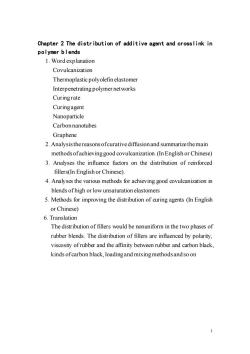
Chapter 2 The distribution of additive agent and crosslink in polymer blends 1.Word explanation Covulcanization Thermoplastic polyolefin elastomer Interpenetrating polymer networks Curingrate Curingagent Nanoparticle Carbonnanotubes Graphene 2.Analysis the reasons ofcurativediffusionand summarize the main methods ofachieving good covulcanization.(In English or Chinese) 3.Analyses the influence factors on the distribution of reinforced fillers(In English or Chinese). 4.Analyses the various methods for achieving good covulcanization in blends ofhigh or low unsaturation elastomers 5.Methods for improving the distribution of curing agents(In English or Chinese) 6.Translation The distribution of fillers would be nonuniform in the two phases of rubber blends.The distribution of fillers are influenced by polarity, viscosity of rubber and the affinity between rubber and carbon black kinds ofcarbon black,loading and mixing methods and so on
3 Chapter 2 The distribution of additive agent and crosslink in polymer blends 1. Word explanation Covulcanization Thermoplastic polyolefin elastomer Interpenetrating polymer networks Curing rate Curing agent Nanoparticle Carbon nanotubes Graphene 2. Analysis the reasons of curative diffusion and summarize the main methods of achieving good covulcanization. (In English or Chinese) 3. Analyses the influence factors on the distribution of reinforced fillers(In English or Chinese). 4. Analyses the various methods for achieving good covulcanization in blends of high or low unsaturation elastomers 5. Methods for improving the distribution of curing agents (In English or Chinese) 6. Translation The distribution of fillers would be nonuniform in the two phases of rubber blends. The distribution of fillers are influenced by polarity, viscosity of rubber and the affinity between rubber and carbon black, kinds of carbon black, loading and mixing methods and so on

Chapter 3 Blending in general rubbers 1.Word explanation Natural rubber Butadienerubber Solutionparameter Butadiene styrenerubber Ethylene-Propylene-Diene Monomer 2.Analyses the characteristics ofNR structure and BR structure. What's the main aim of NR/BR blend?(In English) 3.Analyses the characteristics ofNR structure and SBR structure and Compare the characters ofboth components.What's the main aim of NR/SBR blend?(In English) 4.The applicationofNR or the blends of NR with other rubber(In English or Chinese)? 5.Factors that influence the covulcanization ofrubber blends(In English)? 6.Factors that influence the distribution offillers in rubber blends(In English)? 7.List the main kinds ofrubber and their blends(In English)? 8.Translation a.The main application of NR/BR blends is used in tyre especially in tyretread. b.Improving the heat generation,abrasion resistance,slip resistance and freeze resistance. c.Reducingcompoundcost
4 Chapter 3 Blending in general rubbers 1. Word explanation Natural rubber Butadiene rubber Solution parameter Butadiene styrene rubber Ethylene-Propylene-Diene Monomer 2. Analyses the characteristics of NR structure and BR structure. What’s the main aim of NR/BR blend? (In English) 3. Analyses the characteristics of NR structure and SBR structure and Compare the characters of both components.What’s the main aim of NR/SBR blend? (In English) 4. The application of NR or the blends of NR with other rubber(In English or Chinese)? 5. Factors that influence the covulcanization of rubber blends(In English)? 6. Factors that influence the distribution of fillers in rubber blends(In English)? 7. List the main kinds of rubber and their blends(In English)? 8. Translation a. The main application of NR/BR blends is used in tyre especially in tyre tread. b. Improving the heat generation, abrasion resistance, slip resistance and freeze resistance. c. Reducing compound cost
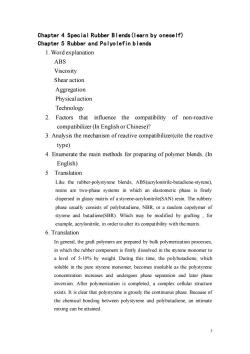
Chapter 4 Special Rubber Blends(learn by oneself) Chapter 5 Rubber and Polyolefin blends 1.Word explanation ABS Viscosity Shear action Aggregation Physical action Technology 2.Factors that influence the compatibility of non-reactive compatibilizer(In English or Chinese)? 3.Analysis the mechanism of reactive compatibilizer(cite the reactive type) 4.Enumerate the main methods for preparing of polymer blends.(In English) 5 Translation Like the rubber-polystyrene blends,ABS(acrylonitrile-butadiene-styrene). resins are two-phase systems in which an elastomeric phase is finely dispersed in glassy matrix of a styrene-acrylonitrile(SAN)resin.The rubbery phase usually consists of polybutadiene,NBR,or a random copolymer of styrene and butadiene(SBR).Which may be modified by grafting,for example,acrylonitrile.in order to alter its compatibility with the matrix 6.Translation In general,the graft polymers are prepared by bulk polymerization processes, in which the rubber component is firstly dissolved in the styrene monomer to a level of 5-10%by weight.During this time,the polybutadiene,which soluble in the pure styrene monomer,becomes insoluble as the polystyrene concentration increases and undergoes phase separation and later phase inversion.After polymerization is completed,a complex cellular structure exists.It is clear that polystyrene is grossly the continuous phase.Because of the chemical bonding between polystyrene and polybutadiene,an intimate mixing can be attained
5 Chapter 4 Special Rubber Blends(learn by oneself) Chapter 5 Rubber and Polyolefin blends 1. Word explanation ABS Viscosity Shear action Aggregation Physical action Technology 2. Factors that influence the compatibility of non-reactive compatibilizer (In English or Chinese)? 3. Analysis the mechanism of reactive compatibilizer(cite the reactive type) 4. Enumerate the main methods for preparing of polymer blends. (In English) 5 Translation Like the rubber-polystyrene blends, ABS(acrylonitrile-butadiene-styrene), resins are two-phase systems in which an elastomeric phase is finely dispersed in glassy matrix of a styrene-acrylonitrile(SAN) resin. The rubbery phase usually consists of polybutadiene, NBR, or a random copolymer of styrene and butadiene(SBR). Which may be modified by grafting , for example, acrylonitrile, in order to alter its compatibility with the matrix. 6. Translation In general, the graft polymers are prepared by bulk polymerization processes, in which the rubber component is firstly dissolved in the styrene monomer to a level of 5-10% by weight. During this time, the polybutadiene, which soluble in the pure styrene monomer, becomes insoluble as the polystyrene concentration increases and undergoes phase separation and later phase inversion. After polymerization is completed, a complex cellular structure exists. It is clear that polystyrene is grossly the continuous phase. Because of the chemical bonding between polystyrene and polybutadiene, an intimate mixing can be attained
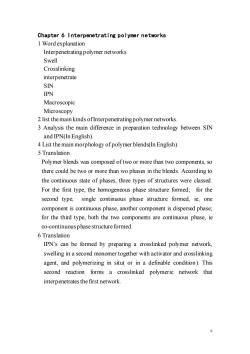
Chapter 6 Interpenetrating polymer networks 1 Word explanation Interpenetrating polymer networks Swell Crosslinking interpenetrate SIN IPN Macroscopic Microscopy 2 list the main kinds ofInterpenetratingpolymer networks. 3 Analysis the main difference in preparation technology between SIN and IPN(In English). 4 List the main morphology ofpolymer blends(In English) 5 Translation Polymer blends was composed oftwo or more than two components,so there could be two or more than wo phases in the blends.According to the continuous state of phases,three types of structures were classed. For the first type,the homogeneous phase structure formed;for the second type, single continuous phase structure formed,ie,one component is continuous phase,another component is dispersed phase; for the third type,both the two components are continuous phase,ie co-continuous phase structure formed. 6 Translation IPN's can be formed by preparing a crosslinked polymer network, swelling in a second monomer together with activator and crosslinking agent,and polymerizing in situ(or in a definable condition).This second reaction forms a crosslinked polymeric network that interpenetrates the first network
6 Chapter 6 Interpenetrating polymer networks 1 Word explanation Interpenetrating polymer networks Swell Crosslinking interpenetrate SIN IPN Macroscopic Microscopy 2 list the main kinds of Interpenetrating polymer networks. 3 Analysis the main difference in preparation technology between SIN and IPN(In English). 4 List the main morphology of polymer blends(In English). 5 Translation Polymer blends was composed of two or more than two components, so there could be two or more than wo phases in the blends. According to the continuous state of phases, three types of structures were classed. For the first type, the homogeneous phase structure formed; for the second type, single continuous phase structure formed, ie, one component is continuous phase, another component is dispersed phase; for the third type, both the two components are continuous phase, ie co-continuous phase structure formed. 6 Translation IPN’s can be formed by preparing a crosslinked polymer network, swelling in a second monomer together with activator and crosslinking agent, and polymerizing in situ( or in a definable condition). This second reaction forms a crosslinked polymeric network that interpenetrates the first network
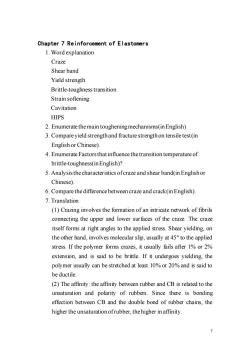
Chapter 7 Reinforcement of Elastomers 1.Word explanation Craze Shear band Yield strength Brittle-toughness transition Strainsoftening Cavitation HIPS 2.Enumerate the main toughening mechanisms(in English) 3.Compare yield strengthand fracture strength on tensile test(in English or Chinese). 4.Enumerate Factors that influence the transition temperature of brittle-toughness(in English)? 5.Analysis the characteristics ofcraze and shear band(in Englishor Chinese) 6.Compare the difference between craze and crack(in English) 7.Translation (1)Crazing involves the formation of an intricate network of fibrils connecting the upper and lower surfaces of the craze.The craze itself forms at right angles to the applied stress.Shear yielding,on the other hand,involves molecular slip,usually at 45 to the applied stress.If the polymer forms crazes,it usually fails after 1%or 2% extension,and is said to be brittle.If it undergoes yielding,the polymer usually can be stretched at least 10%or 20%and is said to be ductile. (2)The affinity:the affinity between rubber and CB is related to the unsaturation and polarity of rubbers.Since there is bonding effection between CB and the double bond of rubber chains,the higher the unsaturationofrubber,the higher in affinity
7 Chapter 7 Reinforcement of Elastomers 1. Word explanation Craze Shear band Yield strength Brittle-toughness transition Strain softening Cavitation HIPS 2. Enumerate the main toughening mechanisms(in English) 3. Compare yield strength and fracture strength on tensile test(in English or Chinese). 4. Enumerate Factors that influence the transition temperature of brittle-toughness(in English)? 5. Analysis the characteristics of craze and shear band(in English or Chinese). 6. Compare the difference between craze and crack(in English). 7. Translation (1) Crazing involves the formation of an intricate network of fibrils connecting the upper and lower surfaces of the craze. The craze itself forms at right angles to the applied stress. Shear yielding, on the other hand, involves molecular slip, usually at 45° to the applied stress. If the polymer forms crazes, it usually fails after 1% or 2% extension, and is said to be brittle. If it undergoes yielding, the polymer usually can be stretched at least 10% or 20% and is said to be ductile. (2) The affinity: the affinity between rubber and CB is related to the unsaturation and polarity of rubbers. Since there is bonding effection between CB and the double bond of rubber chains, the higher the unsaturation of rubber, the higher in affinity
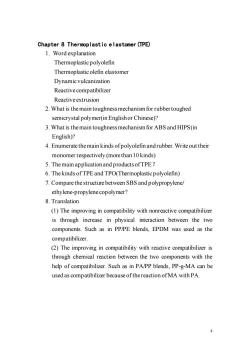
Chapter 8 Thermoplastic elastomer(TPE) 1.Word explanation Thermoplastic polyolefin Thermoplastic olefin elastomer Dynamic vulcanization Reactive compatibilizer Reactive extrusion 2.What is the main toughness mechanism for rubber toughed semicrystal polymer(in English or Chinese)? 3.What is the main toughness mechanism for ABS and HIPS(in English)? 4.Enumerate the main kinds ofpolyolefin and rubber.Write out their monomer respectively.(more than 10 kinds) 5.The main applicationand products ofTPE? 6.The kinds of TPEand TPO(Thermoplastic polyolefin) 7.Compare the structure between SBS and polypropylene/ ethylene-propylene copolymer? 8.Translation (1)The improving in compatibility with nonreactive compatibilizer is through increase in physical interaction between the two components.Such as in PP/PE blends,EPDM was used as the compatibilizer (2)The improving in compatibility with reactive compatibilizer is through chemical reaction between the two components with the help of compatibilizer.Such as in PA/PP blends,PP-g-MA can be used as compatibilizer because of thereaction of MA with PA
8 Chapter 8 Thermoplastic elastomer(TPE) 1. Word explanation Thermoplastic polyolefin Thermoplastic olefin elastomer Dynamic vulcanization Reactive compatibilizer Reactive extrusion 2. What is the main toughness mechanism for rubber toughed semicrystal polymer(in English or Chinese)? 3. What is the main toughness mechanism for ABS and HIPS(in English)? 4. Enumerate the main kinds of polyolefin and rubber. Write out their monomer respectively.(more than 10 kinds) 5. The main application and products of TPE? 6. The kinds of TPE and TPO(Thermoplastic polyolefin) 7. Compare the structure between SBS and polypropylene/ ethylene-propylene copolymer? 8. Translation (1) The improving in compatibility with nonreactive compatibilizer is through increase in physical interaction between the two components. Such as in PP/PE blends, EPDM was used as the compatibilizer. (2) The improving in compatibility with reactive compatibilizer is through chemical reaction between the two components with the help of compatibilizer. Such as in PA/PP blends, PP-g-MA can be used as compatibilizer because of the reaction of MA with PA
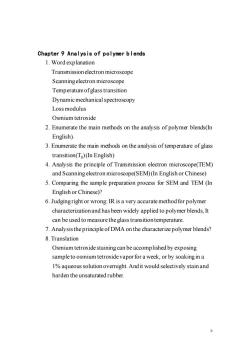
Chapter 9 Analysis of polymer b lends 1.Word explanation Transmission electron microscope Scanning electron microscope Temperature ofglass transition Dynamic mechanical spectroscopy Loss modulus Osmium tetroxide 2.Enumerate the main methods on the analysis of polymer blends(In English). 3.Enumerate the main methods on the analysis of temperature of glass transition(Tg)(In English) 4.Analysis the principle of Transmission electron microscope(TEM) and Scanning electron microscope(SEM)(In English or Chinese) 5.Comparing the sample preparation process for SEM and TEM(In English or Chinese)? 6.Judgingright or wrong:IR is a very accurate method for polymer characterization and has been widely applied to polymer blends,It can be used to measure the glass transition temperature 7.Analysis the principle of DMA on the characterize polymer blends? 8.Translation Osmium tetroxide staining can be accomplished by exposing sample to osmium tetroxide vapor for a week,or by soaking in a 1%aqueous solution overnight.And it would selectively stain and harden the unsaturated rubber. 9
9 Chapter 9 Analysis of polymer blends 1. Word explanation Transmission electron microscope Scanning electron microscope Temperature of glass transition Dynamic mechanical spectroscopy Loss modulus Osmium tetroxide 2. Enumerate the main methods on the analysis of polymer blends(In English). 3. Enumerate the main methods on the analysis of temperature of glass transition(Tg) (In English) 4. Analysis the principle of Transmission electron microscope(TEM) and Scanning electron microscope(SEM) (In English or Chinese) 5. Comparing the sample preparation process for SEM and TEM (In English or Chinese)? 6. Judging right or wrong: IR is a very accurate method for polymer characterization and has been widely applied to polymer blends, It can be used to measure the glass transition temperature. 7. Analysis the principle of DMA on the characterize polymer blends? 8. Translation Osmium tetroxide staining can be accomplished by exposing sample to osmium tetroxide vapor for a week, or by soaking in a 1% aqueous solution overnight. And it would selectively stain and harden the unsaturated rubber
按次数下载不扣除下载券;
注册用户24小时内重复下载只扣除一次;
顺序:VIP每日次数-->可用次数-->下载券;
- 海南大学:《高分子材料共混原理》课程教学大纲 Blending Princlple for Polymers.doc
- 信阳师范大学:《材料科学基础》课程教学资源(PPT课件)第四章 非晶态结构与性质.pptx
- 信阳师范大学:《材料科学基础》课程教学资源(PPT课件)第六章 基本动力学过程——扩散.pptx
- 信阳师范大学:《材料科学基础》课程教学资源(PPT课件)第八章 腐蚀与氧化.pptx
- 信阳师范大学:《材料科学基础》课程教学资源(PPT课件)第五章 表面结构与性质.pptx
- 信阳师范大学:《材料科学基础》课程教学资源(PPT课件)第二章 晶体结构.pptx
- 信阳师范大学:《材料科学基础》课程教学资源(PPT课件)第九章 疲劳与断裂.pptx
- 信阳师范大学:《材料科学基础》课程教学资源(PPT课件)第三章 晶体结构缺陷.pptx
- 信阳师范大学:《材料科学基础》课程教学资源(PPT课件)第七章 材料制备中的固态反应.pptx
- 信阳师范大学:《材料科学基础》课程教学资源(PPT课件)第一章 材料引言(主讲:刘作冬).pptx
- 广西民族大学:金属材料工程专业课程教学大纲汇编(数学与物理学院,2012 年修订).pdf
- 曲阜师范大学:《新型功能材料》课程教学大纲.pdf
- 曲阜师范大学:《材料研究方法》课程教学大纲.pdf
- 曲阜师范大学:《无机非金属材料学》课程教学大纲.pdf
- 曲阜师范大学:《复合材料》课程教学大纲.pdf
- 曲阜师范大学:《催化剂表征》课程教学大纲.pdf
- 曲阜师范大学:《材料物理》课程教学大纲.pdf
- 曲阜师范大学:《材料科学基础》课程教学大纲.pdf
- 曲阜师范大学:《材料化学实验》课程教学大纲.pdf
- 曲阜师范大学:《材料概论》课程教学大纲.pdf
- 海南大学:《高分子材料共混原理》课程教学课件(PPT讲稿)聚合物共混原理 Blending Princlple for Polymers(英文版).ppt
- 《高分子材料共混原理》课程教学资源(PPT课件)第一章 绪论及聚合物共混的热力学.ppt
- 《高分子材料共混原理》课程教学资源(PPT课件)第二章 多组分聚合物的相态结构及其演变.ppt
- 《高分子材料共混原理》课程教学资源(PPT课件)第三章 聚合物共混体系界面形成及表征.ppt
- 《高分子材料共混原理》课程教学资源(PPT课件)第四章 聚合物共混体系的制备及设备.ppt
- 《高分子材料共混原理》课程教学资源(PPT课件)第五章 聚合物共混体系的力学性能.ppt
- 《高分子材料共混原理》课程教学资源(PPT课件)第六章 聚合物增韧改性.ppt
- 《高分子材料共混原理》课程教学资源(PPT课件)第七章 聚合物共混体系的流变性能及其它性能.ppt
- 长春工业大学:《金属工艺学》课程教学大纲 Metal Technology.pdf
- 新疆大学:《结晶学与矿物学》课程授课教案.pdf
- 新疆大学:《结晶学与矿物学》课程教学课件(PPT讲稿)第一章 结晶学概论.ppt
- 新疆大学:《结晶学与矿物学》课程教学课件(PPT讲稿)第二章 矿物的化学成分.ppt
- 福州大学:《材料现代分析方法》课程教学大纲 Moden analysis method of materials.pdf
- 福州大学:《材料现代分析方法》课程教学实验指导书(共四篇多个实验).doc
- 福州大学:《材料现代分析方法》课程教学资源(教案讲义)绪论.doc
- 福州大学:《材料性能学》课程教学大纲.pdf
- 《材料性能学》课程教学课件(PPT讲稿)材料在其他静载下的力学性能.ppt
- 南京林业大学:《包装材料学》课程教学资源(PPT课件)第一章 木材及木质复合包装材料.ppt
- 南京林业大学:《包装材料学》课程教学资源(PPT课件)第二章 纸和纸板包装材料.ppt
- 南京林业大学:《包装材料学》课程教学资源(PPT课件)第三章 塑料包装材料.ppt
